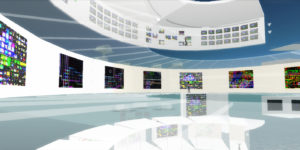The Metaverse: blending surrealism with realism
The metaverse has the potential to change the world with its numerous applications.
March 15, 2022
In 1974, philosopher Robert Nozick wrote about an imaginary machine capable of providing happy experiences that were indistinguishable from real-life possibilities in his book “Anarchy, State, and Utopia”. He discussed whether – when given the choice – humans would choose the machine’s artificial simulation over reality.
Now in 2022, I find myself wondering why anyone would choose reality over a machine that gave them the ability to dream of a world where they could create their own lives, determine their own destiny, and be whoever they wanted to be rather than exist in the body that they did. The machine I’m referring to has now come to life as a far more developed metaverse.
The term was first mentioned in Neal Stephenson’s 1992 novel, “Snow Crash”. It mentioned a 3D virtual world where avatars of real people lived. Similar to Nozick’s machine, it portrayed an escape from reality’s grappling hook: a chance to undo mistakes made in the real world and start afresh.
Though this concept seems advanced, its development may be even more plausible than most think, considering several aspects of the metaverse already exist today. Amongst numerous advancements in technology over the years are augmented and virtual reality. Augmented reality refers to virtual items which are overlaid in a real-world environment, while virtual reality is responsible for the creation of a fully artificial environment. When the two are combined, they produce a visual representation of the physical world – a place many of us have grown accustomed to.
I believe that this virtual world dispenses a positive space of enhanced communication and interaction with others and provides easy access to alternatives of real-life items. However, there is still a long way to go to make it a safe and sustainable platform as an alternative to the physical world.
So how would the mass use of the metaverse impact us?
Envisioning the metaverse:
Let us envision my future 24-hour routine. On average, let’s say I sleep for eight hours and am awake for around 16 hours. Out of these 16 hours, I could choose to split my time equally between the metaverse and reality, eight hours in both worlds.
The possibilities are endless and eight hours a day is more than sufficient to explore them while settling into a daily routine. I may explore the wide array of entertainment that is readily available, or interact virtually with my friends and family living across the world.
As of early 2022, the metaverse is still in its infancy and the technology – such as headsets – used to access the virtual world is also evolving. Two largely used headsets are the Oculus Quest 2 and HP Reverb G2 VR Headsets, both loaded with controllers, in-ear headphones, link cables and facial interface features that help one immerse themselves into a VR environment. However, these headsets are far from perfect. Having to carry their weight for hours on end is a great inconvenience and will cause users to feel dizzy, fatigued, or unbalanced after a certain amount of time. Personally, I would not be able to wear them for the entire eight hours I spend online, without experiencing similar side effects.
Despite all the factors that content creators and coders have to take into consideration while building these platforms, the future of the metaverse is envisioned to provide a variety of surreal experiences.
Entertainment
It’s impossible to evade the metaverse today. I, along with others my age, have grown up in the digital era where playing video games and spending hours online is the new norm. The COVID pandemic further normalized meeting in virtual workspaces and attending virtual events, when venturing outside wasn’t an option. Each one of these metaverse-based activities familiarizes us with the possibility of a world online. Their affordability and accessibility also add to their value.
Take “Fornite” for example, a game that Business of Apps reported as played by 350 million registered users in 2021. The game is solely based in a virtual environment where players team up to battle other characters and imitate real-life actions. Other notable mentions are “Roblox” and “Minecraft” – both based in virtual worlds, similar to “Fortnite”.
Aside from games, the concept of virtual concerts – which was previously lesser-known – has been brought to light during the pandemic. 2020 saw singers such as Dua Lipa and John Legend turn to Instagram and YouTube live streams, to keep performing informally.
However, breakthroughs occurred over the next year and a half, when other world-famous singers such as Ariana Grande, Travis Scott, J Balvin, Lil Nas X and Twenty One Pilots took to gaming platforms “Fortnite” and “Roblox” to host free virtual concerts for their large fanbases.
These concerts seem so much more feasible than concerts in the physical world. Not only were they accessible to a larger audience, but their ingenious use of VR highlighted the flexibility of solutions that the metaverse can provide.
If their popularity continues to grow and people continue transitioning to virtual means of entertainment instead of physical events that are often inaccessible, I foresee even larger VR concerts in our near future.
Communication
The implications of the COVID pandemic restricted our ability to go to a friend’s house or head down to T4 without any qualms about social distancing. While these impositions prove that we often face unsolvable problems within reality, multiple solutions lie within the virtual world.
Instead of traditional methods of communicating online (ie. messaging and calling people), your avatar can be face-to-face with the person you are talking to, in a shared virtual environment. Although video conferencing platforms such as Zoom and Google Meet fulfill the purpose of calls, they do not always enable engaging experiences.
As Meta CEO Mark Zuckerberg shared during his Facebook Connect 2021 event in October 2021, this feature makes it seem like “You’re right in the room together, making eye contact, having a shared sense of space and not just looking at a grid of faces on a screen.”
The idea of togetherness seems impossible after being separated from loved ones in other parts of the world for almost two years, but to me, interacting via the metaverse sounds like the next best thing.
The only qualm about this new method of communication is its effectiveness in communicating emotions and body language. Avatars are depictions of artificial intelligence that do not possess the ability to emote yet. When speaking ‘face-to-face’ with the avatar of another individual on the metaverse, it will be difficult to analyze their intentions and feelings without facial expressions that give it away. This disadvantage restricts users from personally connecting with others.
One way I would go about improving the quality of interactions is by establishing features wherein the user’s facial expressions, body language and mannerisms are evident to others during interactions. This provides an opportunity to create a realistic depiction of oneself and come off a certain way to others.
Apart from communications, the virtual world is set to elevate the affordability of experiences such as virtually traveling and working remotely in different countries. These opportunities offer individuals job experience while giving them the chance to visit different countries and explore the world online, which may not have been possible due to the physical and economic barriers of the real world.
In my opinion, this is beneficial for both employees and employers, as well as the economies of countries that continue to grow. Working in different countries will make individuals more open-minded and aware of the culture and norms around the world.
Careers and opportunities
With a growing need for experts in the field of technology, the metaverse is bound to comply with its own set of necessary job-holders. With that being said, by the time the new generations have grown up and set out into the workforce, traditional jobs may be of lesser importance than they are now.
Amongst numerous positions of responsibility within the development of the virtual world comes the role of research scientists and safety managers, who work alongside each other to ensure the relevance and safety of content being put out on the virtual forum. I believe this role is of utmost importance since critics regard unsafe behavior (data leaks, unsafe interactions with avatars of real people, etc.) as a large concern. Its prioritization might be able to sway more people in favor of the metaverse.
To accomplish their safety goals, safety managers must be aware of the possible uses of different features of the metaverse and ensure that there are no loopholes that can be bypassed and unsafe content which could be exposed to a large scale audience.
Along with this self-check, comes the need for beta-testers. They will have prior access to items in the metaverse and check their functionalities to make sure there are no bugs or incomplete aspects.
Perhaps the most important job of all is to build the world itself. Code must be written to programme different features: cameras and headsets to access, enter and live in the virtual world must be built. Budget planners must work alongside builders to allocate a sum of money towards building each part. Each job is equally as important to ensure that the virtual transition runs smoothly.
The creation of the metaverse
As of early 2022, the metaverse is in the early stages of development and production. It is far from fully formed but many prominent technology companies have a clear vision of what they want to contribute to the virtual world.
One of the largest technology companies in the world, Meta – who rebranded to position themselves as pioneers in the development of the metaverse – have already expanded their line of Oculus headsets to access the world of VR. Apple is following up with headsets that will support both AR and VR capabilities. Platform players such as Microsoft and Epic Games have pledged to aid in the creation of the metaverse while Nvidia agreed to lay the foundation for the code. Each of these creations is necessary to model the metaverse.
Unfortunately, some large companies have been hit with allegations about breaches of privacy in the past. The only way to gain the trust of their audience is by redirecting their collection of data towards areas such as user engagement and community building, instead of monetizing the personal information of users. This will aid research scientists in continuously improving features on the metaverse and protecting the safety of individuals at the same time. In doing so, technology companies will attract a larger audience to their platforms.
In conclusion, the metaverse still has more ground to cover before platforms become fully operational and more and more people begin to use them. Certain factors such as relevance, engagement, safety, security and sustainability need to be considered during their development. Without them, it is impossible to achieve mass usage of the metaverse and begin a steady virtual transition.
As the metaverse starts to eliminate the constraints imposed by the physical world, humans will start to adapt and navigate seamlessly between the surreal and real worlds.




